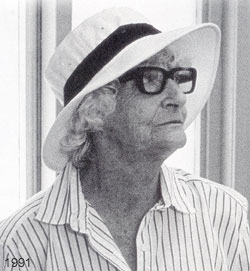
Council of Heads of Australasian Herbaria
Australian National Herbarium
Biographical Notes
 |
Council of Heads of Australasian Herbaria |
 |
Born Morley, Yorkshire, UK, in 1912, died Cooktown 19 May 1999.
Vera Scarth-Johnson OAM (1912-), botanical collector, artist and farmer, was born in Morley, near Leeds, Yorkshire, England, daughter of Herbert Johnson, musician and Grace, née Scarth. After her schooling at Saltburn-by-the-Sea Vera was sent to finishing school in Paris, where she found little of interest except the garden. She was keen to pursue a horticultural career but could not find an employer willing to take on a woman apprentice. Instead she filled in time by attending Leeds College of Art and after five years working at various jobs had saved enough money to complete a horticultural course at the Hertfordshire Institute of Agriculture.
Later she worked for a Leeds market garden until her grandfather, a wealthy woollen manufacturer, by now resigned to her implacable choice of career, gave her �2000 to start a piggery and market garden of her own.
After the Second World War, Vera Scarth-Johnson emigrated to Australia and worked briefly for a Melbourne market garden before settling in the Wide Bay district of Queensland. There she purchased a 30 ha property near Bundaberg, initially to grow vegetables and tobacco, but soon switching to sugar cane. She was only the second woman to secure a cane assignment. In the evenings, particularly in winter when farm work was less demanding, Vera sketched and painted flowers. In the mid- 1960s she heard a radio interview featuring Sir George Taylor, Director of the Royal Botanic Gardens, Kew, England. He was discussing how poorly funded botany was and how the Gardens relied heavily on the voluntary assistance of collectors around the world. Vera wrote to Taylor offering collected help and enclosed some of her drawings, so beginning a long association with herbariums at Kew and in Australia. 1977
Vera's collecting trips, all at personal expense, took her to many parts of Herbarium) Australia - from the Snowy Mountains in the south to Cape York in the I north, and west to the Pilbara and Kimberley areas of Western Australia. In 1967 she visited Tofua, an island near Tonga. As she assiduously collected for Kew, Vera collected botanical specimens for the herbarium in the home state or country in which she was working. In this way the Queensland Herbarium has acquired 1700 specimens, the last dating from 1987 when failing health prevented her continuing.
In 1972 Vera Scarth-Johnson moved north to Cooktown and began collecting and painting the local flora. Inspired by the beauty of the Endeavour River and by the early botanical work of Joseph Banks and Daniel Solander on Captain Cook's voyage of discovery, she set out to paint 200 of the area's known plants. The onset of Parkinson's disease brought the project to an end at 175 paintings. In 1990 Vera gave these to the people of Cooktown to enrich public appreciation of the Endeavour River area.
In 1997 she was still living in Cooktown and actively campaigning against developments that could change what she calls 'her river'. In 1995 Vera was awarded an Order of Australia Medal for her contribution to art and the environment. Her name is commemorated in the shrub Argophyllum verae.
She died in Cooktown on 19 May 1999.
See Obituary from the Cooktown Local News, Issue No.200, 20 May, 1999
Example of her artwork:
Source: extracted from: John Clarkson in Brilliant Careers, Judith
McKay (ed) 1997, Queensland Museum
Photo Portraits: 1) not attributed, news-mail.com.au website Saturday February 24 2018 2) John Clarkson in Brilliant Careers, Judith
McKay (ed) 1997, Queensland Museum